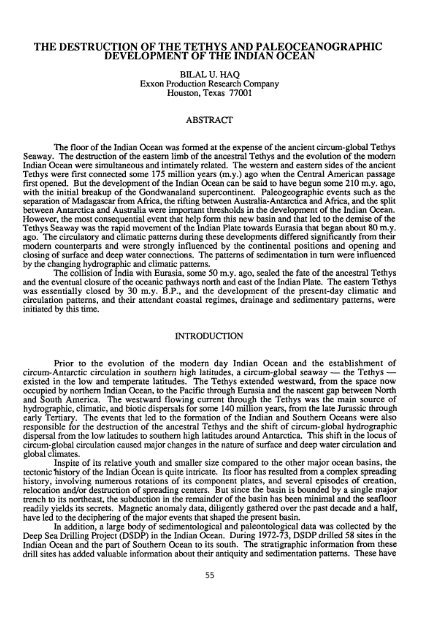139736eo.pdf (20MB) - Japan Oceanographic Data Center
139736eo.pdf (20MB) - Japan Oceanographic Data Center
139736eo.pdf (20MB) - Japan Oceanographic Data Center
- No tags were found...
You also want an ePaper? Increase the reach of your titles
YUMPU automatically turns print PDFs into web optimized ePapers that Google loves.
THE DESTRUCTION OF THE TETHYS AND PALEOCEANOGRAPHICDEVELOPMENT OF THE INDIAN OCEANBILAL U. HAQExxon Production Research CompanyHouston, Texas 77001ABSTRACTThe floor of the Indian Ocean was formed at the expense of the ancient circum-global TethysSeaway. The destruction of the eastern limb of the ancestral Tethys and the evolution of the modernIndian Ocean were simultaneous and intimately related. The western and eastern sides of the ancientTethys were first connected some 175 million years (m.y.) ago when the Central American passagefirst opened. But the development of the Indian Ocean can be said to have begun some 210 m.y. ago,with the initial breakup of the Gondwanaland supercontinent. Paleogeographic events such as theseparation of Madagascar from Africa, the rifting between Australia-Antarctica and Africa, and the splitbetween Antarctica and Australia were important thresholds in the development of the Indian Ocean.However, the most consequential event that help form this new basin and that led to the demise of theTethys Seaway was the rapid movement of the Indian Plate towards Eurasia that began about 80 m.y.ago. The circulatory and climatic patterns during these developments differed significantly from theirmodem counterparts and were strongly influenced by the continental positions and opening andclosing of surface and deep water connections. The patterns of sedimentation in turn were influencedby the changing hydrographic and climatic patterns.The collision of India with Eurasia, some 50 m.y. ago, sealed the fate of the ancestral Tethysand the eventual closure of the oceanic pathways north and east of the Indian Plate. The eastern Tethyswas essentially closed by 30 m.y. B.P., and the development of the present-day climatic andcirculation patterns, and their attendant coastal regimes, drainage and sedimentary patterns, wereinitiated by this time.INTRODUCTIONPrior to the evolution of the modern day Indian Ocean and the establishment ofcircum-Antarctic circulation in southern high latitudes, a circum-global seaway - the Tethys -existed in the low and temperate latitudes. The Tethys extended westward, from the space nowoccupied by northern Indian Ocean, to the Pacific through Eurasia and the nascent gap between Northand South America. The westward flowing current through the Tethys was the main source ofhydrographic, climatic, and biotic dispersals for some 140 million years, from the late Jurassic throughearly Tertiary. The events that led to the formation of the Indian and Southern Oceans were alsoresponsible for the destruction of the ancestral Tethys and the shift of circum-global hydrographicdispersal from the low latitudes to southern high latitudes around Antarctica. This shift in the locus ofcircum-global circulation caused major changes in the nature of surface and deep water circulation andglobal climates.Inspite of its relative youth and smaller size compared to the other major ocean basins, thetectonic ‘history of the Indian Ocean is quite intricate. Its floor has resulted from a complex spreadinghistory, involving numerous rotations of its component plates, and several episodes of creation,relocation and/or destruction of spreading centers. But since the basin is bounded by a single majortrench to its northeast, the subduction in the remainder of the basin has been minimal and the seafloorreadily yields its secrets. Magnetic anomaly data, diligently gathered over the past decade and a half,have led to the deciphering of the major events that shaped the present basin.In addition, a large body of sedimentological and paleontological data was collected by theDeep Sea Drilling Project (DSDP) in the Indian Ocean. During 1972-73, DSDP drilled 58 sites in theIndian Ocean and the part of Southern Ocean to its south. The stratigraphic information from thesedrill sites has added valuable information about their antiquity and sedimentation patterns. These have55
















